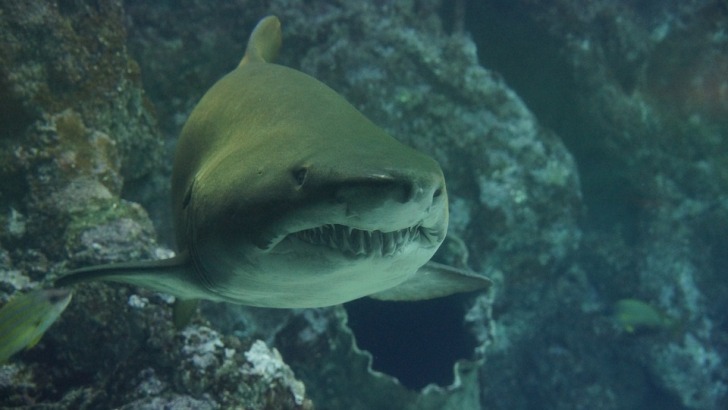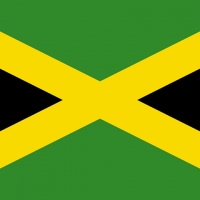Welcome to the Grand Strand, home of Salty the Shark and Rally Shark, two local mascots often spotted stalking the sands.
While there are some cute and cuddly sharks, not all sharks you spot in Myrtle Beach, South Carolina are as friendly or safe.
Myrtle Beach is situated on the East Coast of the continental US.
But do they have real sharks in Myrtle Beach?
Yes, they do.
Actually, there are more than three dozen species of sharks.
Find out what kind of sharks are swimming in Myrtle Beach and whether it is safe to swim in the water with sharks.
Contents
- So… Are There Sharks in Myrtle Beach?
- Shark Species in Myrtle Beach
- Is it Safe to Swim in Myrtle Beach?
- Interesting Shark Facts in Myrtle Beach
- Sharks in Freshwater Vs. Saltwater
- 3 Safety Tips for Swimming in Shark-infested Waters
- Summary
- Sources
- Before Going to Myrtle Beach
- Myrtle Beach Safety Overview
- Frequently Asked Questions
So… Are There Sharks in Myrtle Beach?
Yes, there are many shark species that live in Myrtle Beach and the Atlantic Ocean in this part of the Southeast US.
The sharks that live in these waters are active and commonplace.
These include the great white shark, as well as lemon sharks, and other lesser-known species.
According to Sciencing, there are more than 40 types of sharks in Myrtle Beach.
Common sharks in the area include bull sharks, blacktip sharks, tiger sharks, and spinner sharks.
Two of these sharks are extremely predatory towards humans and are known to attack.
This includes bull sharks and tiger sharks, the latter of which is the second most deadly shark for humans.
People swimming in Myrtle Beach get bitten by sharks, and fortunately, most are not fatal wounds.
However, the sharks that do attack are quite vicious and are found still holding on to their victims with their clamping bite.

The bull shark, tiger shark, blacktip shark, and spinner shark are all common in Myrtle Beach, SC.
The bull shark is aggressive even though a shark attack by this type of shark is rare.
One concern with bull sharks is that they are able to travel up a freshwater river in search of prey.
This shark is part of the requiem shark species, as is this next shark.
The tiger shark is the second most deadly shark for humans and is quite common here as well.
This carnivorous predator is known to be up to 1,400 pounds in weight and to be 14 feet long.
They have striped tints that darken their flesh, giving the tiger shark its name.
The blacktip shark in Myrtle Beach is an excellent hunter by scent and can “detect one part of fish flesh in 10 billion parts of seawater,” according to Oceana.
An interesting fact about blacktip sharks, which do have a very distinct black tip on their fins, is the spinning movement they make.
These sharks spin in the air and can perform up to three rotations out of the water.
That is quite extraordinary for a creature of the wild, blue, and deep.
Then we have the spinner shark, which ironically also spins as its name suggests.
The spinner shark is also part of the requiem shark species, and this shark has bitten humans.
Fortunately, no one has ever died from a spinner shark bite, perhaps because the shark has a narrow jaw and small teeth.
The spinner shark is also smaller in size, weighing an average of 123 pounds.
Here are saltwater shark species in South Carolina that may be found in Myrtle Beach:
- Atlantic Sharpness shark
- Blacknose shark
- Blacktip shark
- Bonnethead
- Dusky shark
- Finetooth shark
- Sandbar shark
- Sand Tiger
- Scalloped Hammerhead
- Silky shark
These are all coastal sharks found in saltwater and range from small to large in size.
Is it Safe to Swim in Myrtle Beach?
Compared to other coastal regions in the US, there is a high risk that you could see a shark when swimming in Myrtle Beach.
This means you will also be more likely to get attacked by a shark, which can mean being bitten by a shark and possibly dragged underwater and drowning.
South Carolina’s coast is a hotbed for shark activity.
There are several sharks that are tagged and pinged using satellite data off the coast of Myrtle Beach, SC.
You can see this alive and for free on your computer using the Ocearch Shark Tracker.
These include a great white named Mahone, as well as these sharks from the Ocearch Shark Tracker:
- Georgia, a sub-adult tiger shark that weighs 253 pounds
- Teazer, a sub-adult white shark that is 10 feet and 9 inches long weighs 651 pounds. It is very active, returning to Merle Beach annually; the shark was named for a ghost ship
- Martha, a juvenile white shark that is 7 feet long and 184 pounds
You can track whatever sharks, such as great white and tiger sharks, are hunting off of the Myrtle Beach coast using the Ocearch Shark Tracker.
This gives you some control over shark attacks and fears about swimming with sharks.
Shark attacks are common in Myrtle Beach, SC, as a result of the number of sharks in the Atlantic Ocean off the coast.
Several species of sharks travel back and forth from Nova Scotia and the Greenland region, where there are cold Arctic waters, and then back down to the warm Florida coastal region during their migratory phase.
This allows the sharks a healthy pathway for mating and feeding, which also puts humans at risk when swimming with sharks in Myrtle Beach.
As Shark Year reports, there was a recent shark attack involving a shark biting a man who was swimming in the ocean in Myrtle Beach.
He was found near the Second Avenue Pier with a shark still attached by the mouth to his foot.
The foot was mangled but the limb was left intact.
This is why you want to avoid swimming with sharks in Myrtle Beach.
Jellyfish are also a threat to swimmers in Myrtle Beach.
The Lion’s Mane jellyfish, which is also called the giant jellyfish, can have 120-foot-long tentacles.
These are similar in size to the blue whale and are some of the biggest jellyfish species in nature.
Swimming with one of these giant jellyfish while in Myrtle Beach will most likely sting and be painful.

Interesting Shark Facts in Myrtle Beach
If you go to the Second Avenue Pier at 110 North Ocean Boulevard, you can see a bit of folklore and snap a photo to boot!
Here is the catch of the day—a giant shark that is not at all real or stuffed or going to come alive and bite you.
Get a photo to see how you stack up when standing nose to toe with a real-looking and life-sized replica of this local marine beast.
Searching for shark teeth in Myrtle Beach is a popular activity.
The North Myrtle Beach area is better suited and more successful for beachcombers interested in shark tooth hunting.
It is recommended that you take a small net to sift through sand and wear sunglasses and water shoes to make shark tooth hunting easier.
There are local beach shops that sell supplies specifically for finding shark teeth.
You can even download a Shark Teeth Mobile app to help identify shark teeth you collect at Myrtle Beach.
The most prized shark tooth to find is the megalodon shark tooth, but you are more likely to find a lemon shark tooth instead.
The sharks in Myrtle Beach are all saltwater sharks that require saltwater buoyancy and saliency to survive.
If they enter a brackish freshwater reserve, such as down a river or in a lake, they can live for a short period of time.7
However, this is a bold move to make like a shark, and almost always indicates they are starving and need something to eat.
Preferably large since they traveled so far to find food.
The waters of Myrtle Beach are warm tropical waters with the coldest month being March when the ocean is 57.7 degrees F on average.
The warmest month for Myrtle Beach water temperature is August when the water heats up to a scorching 82.8 degrees F.
What time of the year are sharks more active in saltwater in Myrtle Beach?
The most common time for sharks to attack is daytime during the summer months.
It is clear why.
There are more tourists and people swimming in the water.
This increases the chances that sharks are going to run into humans.
However, the sharks in the Atlantic are also cold-blooded and swim the currents through Myrtle Beach all year long.
Also, in the fall season of August, when summer heats up, so do the waters.
This can make sharks testy, as they start to get overheated just like humans.
3 Safety Tips for Swimming in Shark-infested Waters
- If a shark attacks you while swimming in shark-infested waters, put up your dukes! Fighting back is key to survival at this point, and it does help to put your thumbs in a shark’s eye.
- Be wary even in shallow waters while swimming in Myrtle Beach, SC. The sharks are likely to think your feet or ankles are fish or dolphin fins in the waves due to the reflection of the sunlight.
- Do not swim alone in Myrtle Beach waters. This is the biggest threat, as sharks will attack one person far more often than a group of people. If you are swimming by yourself, you also have no one to run to and call for help if you are attacked.

Summary
Sharks are very common in Myrtle Beach, South Carolina, and the Atlantic Ocean.
Here is the home to many sharks that are seen as the most dangerous to humans, as well.
This includes the bull shark, the great white shark, and the tiger shark.
Some of the regional sharks that are local to the Atlantic region include the Atlantic Sharpness, Blacknose, Bonnethead, Dusky, Finetooth, Sandbar, Scalloped Hammerhead, and Silky sharks.
When swimming in Myrtle Beach, especially North Myrtle Beach, you want to be on the lookout for signs of sharks in the water.
This starts with checking online shark trackers and apps that track sharks and sea life, as well as local news regarding shark sightings.
Look for fins in the water, as well as jumping and flying sharks, such as the spinner shark that commonly spins in the air.
These indicators of sharks in the water can help save your life when swimming in Myrtle Beach.
Otherwise, there is more danger in crabbing in Alaska compared to swimming in Myrtle Beach with sharks in the water.
Be safe even in shallow waters and stay alert and off of floats, is my final word of caution.
Sources
- https://sciencing.com/kind-myrtle-beach-south-carolina-8177761.html
- https://www.nwf.org/Educational-Resources/Wildlife-Guide/Fish/Bull-Shark
- https://www.nationalgeographic.com/animals/fish/facts/bull-shark
- https://www.nature.org/en-us/get-involved/how-to-help/animals-we-protect/tiger-shark/
- https://oceana.org/marine-life/blacktip-shark/
- https://www.nationalgeographic.com/animals/fish/facts/blacktip-shark
- https://www.sharks.org/spinner-shark-carcharhinus-brevipinna
- https://www.dnr.sc.gov/pubs/SaltwaterFishID.pdf
- https://www.ocearch.org/tracker/
- https://www.sidmartinbio.org/what-kind-of-sharks-in-the-myrtle-beach-area/
- https://www.ocearch.org/tracker/detail/georgia
- http://sharkyear.com/2012/shark-attack-at-myrtle-beach.html
- https://www.sidmartinbio.org/what-kind-of-sharks-in-the-myrtle-beach-area/
- https://oceana.org/marine-life/lions-mane-jellyfish/
- https://www.visitmyrtlebeach.com/listing/second-avenue-pier/211/
- https://www.northmyrtlebeach.com/blog/shark-teeth/
- https://www.seatemperature.org/north-america/united-states/myrtle-beach.htm
- https://www.scubadivingearth.com/are-there-any-sharks-in-myrtle-beach-9-common-sharks/
- https://www.myrtlebeach.com/sharks/
- https://www.nationalgeographic.com/animals/article/shark-attacks-atlantic-ocean
- https://www.thoughtco.com/top-shark-attack-species-2291452
Before Going to Myrtle Beach
Check out our safety report:
Myrtle Beach Safety Overview
READ THE FULL REPORT: Myrtle Beach Safety Review
Safety Index:
- OVERALL RISK: MEDIUM
- TRANSPORT & TAXIS RISK: MEDIUM
- PICKPOCKETS RISK: HIGH
- NATURAL DISASTERS RISK: LOW
- MUGGING RISK: MEDIUM
- TERRORISM RISK: LOW
- SCAMS RISK: MEDIUM
- WOMEN TRAVELERS RISK: MEDIUM
Frequently Asked Questions
What is the way most people get attacked by sharks in Myrtle Beach and other shark-infested waters?
By being a surface recreationalist.
Avoid floating on the surface as a recreationalist, which is someone paddleboarding or surfing and using a floatation device.
This mimics the body of a seal and makes you more susceptible thanks to your flailing hands and feet, especially when wearing jewelry.
Are shark attacks more frequent in the Atlantic Ocean or the Pacific Ocean?
According to National Geographic, shark attacks are more common in the Atlantic Ocean.
Which sharks are more likely to attack someone and bite them when swimming with sharks in Myrtle Beach?
The most common sharks that attack humans are, in order of commonality, white sharks; tiger sharks and sand tiger sharks; and bull sharks.
White sharks attack humans three times more often than tiger sharks and bull sharks, which attack humans at about the same rate.












I know I will not be swimming in myrtle beach waters,I will do my swimming in the pool’s,thank you for all the information of shark’ swimming in Myrtle beach,I learned alot from you.Tina Sadler
It’s amazing to me that people have to ask if there are sharks at Myrtle Beach or any other beach along either coast. It’s the Ocean, folks, sharks live in the seas that cover the planet, everywhere. When you enter the water you are entering their home.
I just returned home from Myrtle Beach and I checked daily the sites showing the tagged sharks in the area, and not because I wanted to swim. I don’t swim anywhere the fish are larger than my Chevy Suburban, but I did go and look at the sea. I saw people fishing from the beach and other people swimming less than 100 feet away! smh And yes, there were sharks pinging in the area, but only the tagged ones.
If you go into the Atlantic or Pacific Ocean you will be swimming with sharks, period. If you get bitten it won’t be the sharks fault, that’s what they do. In that famous line from Matt Hooper: “It’s a perfect engine, an eating machine. All this machine does is swim and eat and make little sharks, and that’s all.” I hope everyone keeps that in mind the next time they head to the beach, Myrtle or any other.